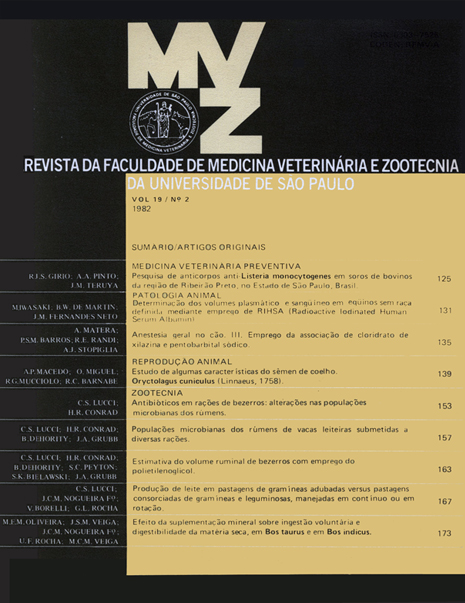The influence of mineral supplementation upon the voluntary green forage intake and on the dry matter digestibility comparatively in Bos taurus and Bos indicus
DOI:
https://doi.org/10.11606/issn.2318-3659.v19i2p177-182Keywords:
Bovines, Bos taurus, Bos indicus, Food digestibility, MineralsAbstract
To compare the influence of mineral supplementation upon green forage intake and digestibility between B. taurus and B. indicus, four heifers of the first breed and four of the second one were stabled in individual pens and given "ad libitum ” common salt, fresh water and green, daily cropped grass (Pennisetum purpureum Schum). After allowing the heifers over a period of 20 days to adapt themselves from field conditions, (under which they had been kept so far), daily measurements of individual grass consumption were done for 10 days period 1st experimental phase).Following this period the common salt remaining in each trough was removed and substituted by two commercial mineral mixtures, one containing salt supplemented with "macro-elements" and the other one salt supplemented with ''micro-elements''. According to the manufacturer’s recomendations the two supplemental mixtures were put in each individual trough but there separated by a board partition. Food intake measurements were discontinued for 20days; to allow the heifers a time period for adaptation to these new conditions after which daily individual green forage onsumptions were measured again for a new 10 days period (2nd experimental phase). Mineral supplementation resulted in significantly higher green forage intake both in B. taurus (from 4.484,4g ± 51,3g to 5.221,1g ± 201,6g) and in B. indicus (from 3.631,3g ± 111,8g to 4.166,4g ± 183,3g). Results concerning digestibility between breed groups disagreed, for while in the B. taurus heifers there was a significant rise in the digestibility coefficient (from 42,4% ± 1,1% to 47,2% ± 0,4%) and in the B. indicus heifers no significant differences were found in digestibility, whose coefficient was slightly, but not significantly, smaller during the supplementation period (from 47,4% ± 1,1% to 45,7% ± 1,1%).


